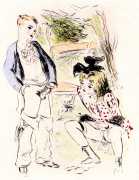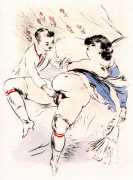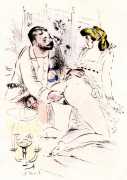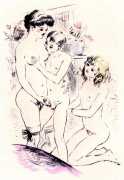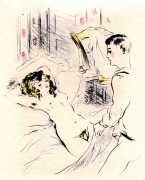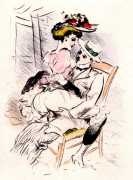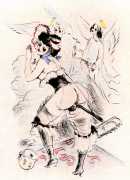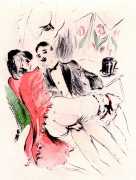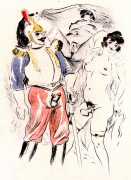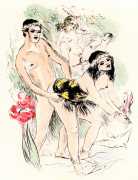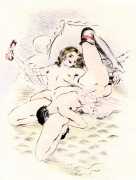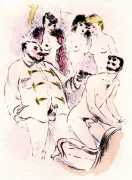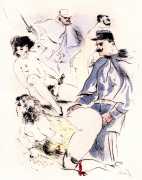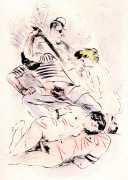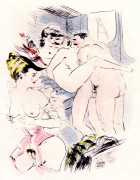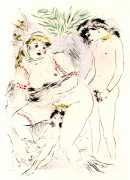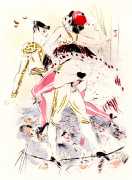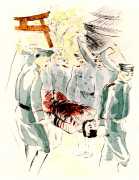
Guillaume Apollinaire (1880–1918) was one of the most inventive, original and iconoclastic writers of the early twentieth century, among other achievements credited with coining the term Cubism in 1911 to describe the emerging art movement and Surrealism in 1917 to describe the musical compositions of Erik Satie. Born Wilhelm Albert Włodzimierz Apolinary Kostrowicki in Rome, he was raised speaking French, Italian and Polish, and moved to France in his late teens, where he adopted his new name.
He quickly became one of the most popular and active members of the artistic community of Paris, his friends and collaborators including Pablo Picasso, Henri Rousseau, Gertrude Stein, André Breton, Jean Cocteau, Erik Satie, Marc Chagall, Marcel Duchamp and Jean Metzinger. He was romantically involved with the writer Marie Laurencin, who is often identified as his muse.
Much of his work is erotic, verging on the pornographic. In 1900 he wrote his first novel, Mirely, ou le petit trou pas cher (Mirely, or The Cheap Little Hole), which is sadly lost. In 1907 he published the well-known erotic novel, Les onze mille verges, ou les amours d’un Hospodar (The Eleven Thousand Rods, or The Story of a Hospodar). Officially banned in France until 1970, Apollinaire never publicly acknowledged authorship of the novel. Another erotic novel attributed to him is Les exploits d’un jeune Don Juan (The Exploits of a Young Don Juan), in which the fifteen-year-old hero fathers three children with various members of his entourage, including his aunt. English translations of both novels were published in 1922 by the Olympia Press under the title The Debauched Hospodar and Memoirs Of A Young Rakehell.
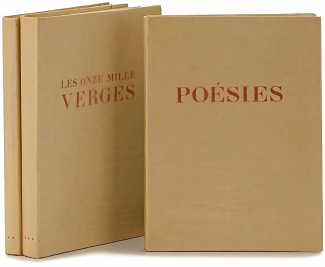 Apollinaire is best known as an experimental poet, especially for his typographical extravaganza Caligrammes. Less well-known are his three short collections of erotic poetry, like Caligrammes published after his untimely death from Spanish flu in November 1918. Cortège priapique (Priapic Parade) appeared in 1925, Julie ou la rose (Julie, or The Rose) in 1927, and Le verger des amours (The Orchard of Love) in 1928. Unfortunately no translation of Apollinaire’s complete erotic poetry has been published, but here is a taster from the beginning of Cortège priapique:
Apollinaire is best known as an experimental poet, especially for his typographical extravaganza Caligrammes. Less well-known are his three short collections of erotic poetry, like Caligrammes published after his untimely death from Spanish flu in November 1918. Cortège priapique (Priapic Parade) appeared in 1925, Julie ou la rose (Julie, or The Rose) in 1927, and Le verger des amours (The Orchard of Love) in 1928. Unfortunately no translation of Apollinaire’s complete erotic poetry has been published, but here is a taster from the beginning of Cortège priapique:
PRIAPIC PARADE
This god we adore is Lampsakos
Who must be brought out of exile
And fly to the aid of Priapus
To rescue women in tears
And chaste vestal virgins
Their cunts lit up with phosphorus.
My cock my beautiful spring
Fill me with your divine liquid
My sweet cucumber, my parsnip,
My rod, my one-eyed snake, my pin,
Come and find your way out.
The tea-rose of your foreskin
Grows and expands;
It looks like an old Russian boyard
That rosy puffy cock,
At the height of the orgy
My mouth sucks your hard knot.
Your thick cum is almond water,
It’s the liquor of my twenties;
Squirt, force your glands
To the point when your cock belching
Fourteenth of July delights me,
Lighting up a beautiful firework display.
From your cum I feel the force
Of your fearlessness,
Tanned by the shadow of your chest
I will end the summer nights
Exhausted! My desire is without remedy
I outperform even Ganymede.
* * *
Mirely, in my summer nights
I remember Léontine
With whom my enchanted cock
Sang matins
Cunt as wide as an estuary
Where my love’s seed often died
You have that fishy flavour
That smell of cock and ass
That fresh odour of used bodies
Woman, oh inexhaustible vagina
Remembering you makes me hard
Your breasts distribute manna
Your thighs, what a pleasure
Even your bloody periods
Produce a violent liqueur
In 1934 the Paris publisher Marcel Lubineau commissioned Berthomme Saint-André to produce illustrations for this three-volume set of Apollinaire’s complete erotic works. Saint-André rose to the occasion, producing this series of wonderfully inventive drawings.
The Lubineau edition of Œuvres erotiques complètes has the imprint ‘A Barcelonette’ (actually Paris of course), and was produced in a numbered edition of 200 sets.
We are very grateful to Philippe Isoard of Librairie In Quarto, Marseille, for these illustrations. The In Quarto catalogue can be found here; where you can buy the set if it is still in stock.


